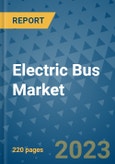As fuel prices continue to soar and concerns over climate change worsen, the global adoption of electric mobility is gaining momentum as a viable solution. Electric vehicles (EVs) offer zero tailpipe emissions, effectively reducing pollution in cities and improving air quality. In line with this movement, the global electric bus market is projected to experience substantial growth throughout the forecast period. Governments and environmental agencies worldwide are supporting the transition to electric buses due to their economic and sustainability benefits. Battery-powered vehicles are cleaner, quieter, and more energy-efficient, making electric buses a promising solution to combat transportation-related pollution. The growing promotion of electric buses through progressive policies and incentives for both customers and manufacturers is expected to drive significant sales and foster long-term market growth.
Sales in Electric Bus Market Surge in Response to Growing Carbon Emissions
Transportation is a leading contributor to pollution and carbon emissions globally. To address this pressing environmental challenge, the adoption of a cleaner and more sustainable transport system is being actively promoted. Electric buses are playing a critical role in shaping a greener future. Apart from their positive impact on the environment, electric buses are also providing a solution to the rising fuel prices. The need to adopt sustainable practices and the inherent economic benefits amidst fuel inflation are driving considerable interest and demand for electric buses. These developments are paving the way for lucrative growth opportunities in the global electric bus market.Growing Demand for 9-14 Meter Length Electric Buses Unlocks New Opportunities
The demand for 9-14 meter length electric buses has witnessed rapid growth in recent years. One of the primary drivers behind this surge is their utility as public transport vehicles. The majority of electric buses in operation today are part of public transportation fleets. Many electric bus manufacturers are actively developing these models to meet the increasing demand for electric public transport vehicles. Additionally, these buses have demonstrated greater reliability and feasibility in real-world usage. The combination of these factors is set to fuel the expansion of the global electric bus market in the forecast period.Favorable Government Norms Establish Asia Pacific as Dominant Market Region
Asia Pacific is poised to dominate the electric bus market, buoyed by increasing electric bus sales, supportive policy-making, and deteriorating air quality. Key regional economies such as China and India are actively promoting the electrification of public transport through subsidies and other customer benefits. China boasts one of the largest electric bus fleets in the world, with over 421,000 buses currently in operation. India is also actively supporting electric vehicle adoption and research and development. These factors are expected to solidify Asia Pacific's position as the leading market region for electric buses.Table of Contents
1. Executive Summary
2. Market Overview
3. Production Output, 2018-2022
4. Price Trends Analysis and Future Projects, 2018 - 2030
5. Global Electric Bus Market Outlook, 2018 - 2030
6. North America Electric Bus Market Outlook, 2018 - 2030
7. Europe Electric Bus Market Outlook, 2018 - 2030
8. Asia Pacific Electric Bus Market Outlook, 2018 - 2030
9. Latin America Electric Bus Market Outlook, 2018 - 2030
10. Middle East & Africa Electric Bus Market Outlook, 2018 - 2030
11. Competitive Landscape
12. Appendix
Companies Mentioned
- Zhengzhou Yutong Bus Co., Ltd.
- BYD bus
- Higer Bus Company Limited
- Zhongtong Bus Holding Co., Ltd.
- Mercedes-Benz Group
- Proterra
- CRRC Corporation Limited
- BAIC Foton Motor Co., Ltd
- PMI Electro Mobility Solutions Private Limited
- AB Volvo
- VDL Groep
- Olectra Greentech
- CAF Group (Solaris)
Methodology

LOADING...








